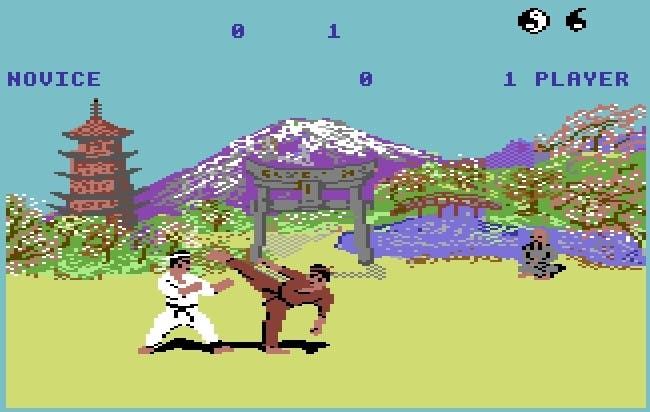The Tao of Beat-'em-ups
Part 1: The evolution of a genre, 1976 to 1985.
"I will not allow myself to indulge in the usual manipulating game of role creation." - Bruce Lee
By 1985, the parameters of what made a good tournament fighter were becoming well established. Most every developer and software house was naked without some form of fighting extravaganza under their banner, and the heat of competition encouraged a wealth of improvement in gameplay, characters and availability of videogame violence.
The tournament fighter was king of the ring; infusing arcades with the kind of rabid passion not seen since Pong and embellishing the home systems with the hard and fast gratification that only ferocious fighting antics can bring.
Way of the Exploding Fist from Melbourne House crashed through the 8-bit barrier without care or consequence - making all other titles released that year seem sedate in comparison. The superb array of moves, realistic graphics, visceral sound effects (featuring a wonderfully shrill Bruce Lee sound sample from Enter The Dragon) and flawless cross-platform performance brought the tournament fighter into people's homes with a vengeance.
The scrolling fighter struggled to translate as well as the tournament games, however, and just as the arcades had done, most of the home system's code was put to work on player-versus-player titles. Bringing home the coin-op fighters became the most desirable option for software houses, and the tide of dynamic, violent and wonderfully engaging beat-'em-ups was just coming in.

In the arcades, the one-on-one continued to ingratiate itself with the kung fu movie fanatics in Konami's 1985 camp classic, Yie Ar Kung Fu (translated from Mandarin as "One Two Kung Fu"!). Pitting Oolong against a variety of diverse antagonists (including the first female characters to appear in a tournament beat-'em-up - long before the famous Chun Li) perfectly exemplified the kitsch frolics of '70s Honk Kong cinema, and provided a damn entertaining fighter to boot.
Yie Ar Kung Fu marked yet another highly significant, if indefinable benchmark in the fighting game's steady evolution. Kung Fu Master had found its way (somewhat lamentably) onto the majority of 8-bit systems, but it's universally lacklustre gameplay didn't do much to progress the genre. Yie Ar Kung Fu, on the other hand, was a categorical success - supported by a wealth of faithful conversions that, coupled with the growing critical success of Way of the Exploding Fist, pushed the beat-'em-up's cause to new heights of respect and recognition.
By 1985, the fighting game genre was fully propagated, ready to complete its gradual evolutionary process and over the next five years beat-'em-ups would rule the gaming world. The fight had begun, but the battle was far from over.

"The key to immortality is living a life worth remembering." - Bruce Lee
When following the sparse chronology of beat-'em-ups, fighting games, one-on-one tournaments and scrolling fighters - whatever you want to call them - there initially appears little to see. But this is a genre that's developed slowly and carefully; biding its time until the technology and audience were harmonised and ready to tolerate its presence.
For the cynical and sectarian, the fighting game genre proves most negative arguments against the value of computer and videogames to be true, but makes no apologies in doing so. Its guttural expression of the raw human animal - free from manmade restrictions of guilt, morality and mercy - is the reason gamers have immersed themselves in the violent, crude, irrational and savage fantasies these games unabashedly deliver.
From our now-distant perspective we can follow a bloodstained breadcrumb trail back through our gaming heritage and see that fighting games were an evolutionary inevitability, and a vital part of gaming history that has supported both players and developers through 25 years of supreme entertainment.







